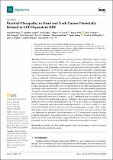| dc.contributor.author | Hanna, Abanob | |
| dc.contributor.author | Casper, Anthony | |
| dc.contributor.author | Dagan, Roi | |
| dc.contributor.author | Grewal, Hardev S. | |
| dc.contributor.author | Park, Jiyeon | |
| dc.contributor.author | Brooks, Eric D. | |
| dc.contributor.author | Traneus, Erik | |
| dc.contributor.author | Glimelius, Lars | |
| dc.contributor.author | Johnson, Perry B. | |
| dc.contributor.author | Saki, Mohammad | |
| dc.contributor.author | Zhang, Yawei | |
| dc.contributor.author | Willoughby, Twyla R. | |
| dc.contributor.author | Bradley, Julie A. | |
| dc.contributor.author | Browne, Jackson | |
| dc.contributor.author | Artz, Mark E. | |
| dc.date.accessioned | 2025-07-02T19:50:12Z | |
| dc.date.available | 2025-07-02T19:50:12Z | |
| dc.date.issued | 2025-05-29 | |
| dc.identifier.uri | https://hdl.handle.net/1721.1/159859 | |
| dc.description.abstract | Proton beam therapy for head and neck cancers traditionally employs a fixed relative biological effectiveness (RBE) of 1.1, which may underestimate actual biological effects in critical structures. This study evaluates how Linear Energy Transfer (LET) optimization could potentially prevent radiation-induced brachial plexopathy (RIBP). (1) Case presentation: A 65-year-old male with stage IVA p16-positive oropharyngeal squamous cell carcinoma received pencil-beam-scanning intensity-modulated proton therapy with concurrent cisplatin. Due to a right level 4 neck node, the high-risk target volume overlapped with the brachial plexus, resulting in a D0.1cc of 70.3 Gy (RBE = 1.1). Four years post-treatment, the patient developed progressive right upper extremity paresthesia, weakness, and dysesthesia. Electromyography revealed myokymia consistent with brachial plexopathy, while MRI showed hyperintensity of the right brachial plexus corresponding to the radiation field. Conservative treatment with pentoxifylline, gabapentin, and physical therapy improved his symptoms. (2) Methods: The original treatment plan was retrospectively analyzed using Monte Carlo dose algorithms and LET-dependent RBE models from McMahon and McNamara. An LET-optimized plan was created to limit LETd to 2.0 keV/µm in the brachial plexus. (3) Results: The relative biological equivalent (RBE) dose to 0.1cc of the brachial plexus was 77.8 Gy (CGE RBE), exceeding tolerance. The LET-optimized plan reduced the brachial plexus D0.1cc to 59.4 Gy (RBE = 1.1) and 63.2 Gy (CGE RBE), an 18.8% decrease, while maintaining target coverage. LETd, within the brachial plexus enhancement, decreased from 5.3 to 2.6 keV/μm. (4) Conclusion: This case highlights the potential clinical importance of LET optimization in proton therapy planning, particularly when organs-at-risk overlap with target volumes. By reducing LETd from 5.3 to 2.6 keV/μm and biological equivalent dose by 18.8%, LET optimization could potentially prevent late toxicities, like RIBP, while maintaining target coverage. | en_US |
| dc.publisher | Multidisciplinary Digital Publishing Institute | en_US |
| dc.relation.isversionof | http://dx.doi.org/10.3390/biophysica5020020 | en_US |
| dc.rights | Creative Commons Attribution | en_US |
| dc.rights.uri | https://creativecommons.org/licenses/by/4.0/ | en_US |
| dc.source | Multidisciplinary Digital Publishing Institute | en_US |
| dc.title | Brachial Plexopathy in Head and Neck Cancer Potentially Related to LET-Dependent RBE | en_US |
| dc.type | Article | en_US |
| dc.identifier.citation | Hanna, A.; Casper, A.; Dagan, R.; Grewal, H.S.; Park, J.; Brooks, E.D.; Traneus, E.; Glimelius, L.; Johnson, P.B.; Saki, M.; et al. Brachial Plexopathy in Head and Neck Cancer Potentially Related to LET-Dependent RBE. Biophysica 2025, 5, 20. | en_US |
| dc.relation.journal | Biophysica | en_US |
| dc.identifier.mitlicense | PUBLISHER_CC | |
| dc.eprint.version | Final published version | en_US |
| dc.type.uri | http://purl.org/eprint/type/JournalArticle | en_US |
| eprint.status | http://purl.org/eprint/status/PeerReviewed | en_US |
| dc.date.updated | 2025-06-25T13:19:10Z | |
| dspace.date.submission | 2025-06-25T13:19:10Z | |
| mit.journal.volume | 5 | en_US |
| mit.journal.issue | 2 | en_US |
| mit.license | PUBLISHER_CC | |
| mit.metadata.status | Authority Work and Publication Information Needed | en_US |
